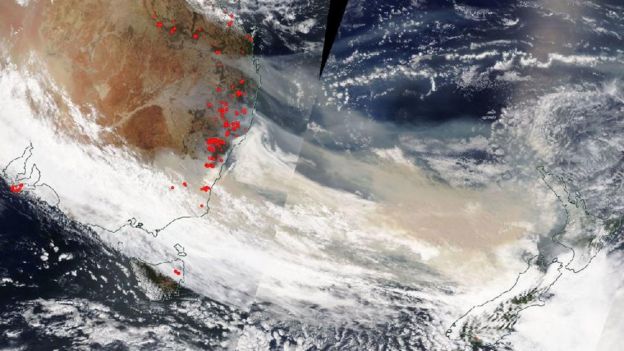Smoke from the massive bushfires in Australia will soon circle the Earth back to the nation, says Nasa.
Massive infernos have raged along the nation's east coast for months, pushing smoke across the Pacific.
Nasa said plumes from blazes around New Year's Day had crossed South America, turning skies there hazy, and moved "halfway around Earth" by 8 January.
"The smoke is expected to make at least one full circuit around the globe," the US space agency said.
Hundreds of bushfires have burnt across Australia, killing at least 28 people and destroying more than 2,000 homes.
 A satellite image showing smoke travelling towards New Zealand on 5 January
The agency said it was studying the effects of smoke at this altitude and whether it provided "a net atmospheric cooling or warming".
A satellite image showing smoke travelling towards New Zealand on 5 January
The agency said it was studying the effects of smoke at this altitude and whether it provided "a net atmospheric cooling or warming".
Bushfire smoke as seen near the International Space Station The unprecedented scale and intensity of the fires has been exacerbated by climate change, experts say.A fleet of NASA satellites ðŸ›°ï¸ working together has been analyzing the aerosols and smoke from the massive fires burning in Australia.https://t.co/93geNvCBnU pic.twitter.com/ZedZ199lvJ
— NASA Goddard (@NASAGoddard) January 9, 2020
How has the smoke travelled around the world?
Nasa said recent blazes had been so big they had produced an "unusually large" number of pyrocumulonimbus events - or fire-generated thunderstorms. These had sent smoke soaring into the stratosphere, with some recorded as high as 17.7km (11 miles). "Once in the stratosphere, the smoke can travel thousands of miles from its source, affecting atmospheric conditions globally," Nasa said. A satellite image showing smoke travelling towards New Zealand on 5 January
The agency said it was studying the effects of smoke at this altitude and whether it provided "a net atmospheric cooling or warming".
A satellite image showing smoke travelling towards New Zealand on 5 January
The agency said it was studying the effects of smoke at this altitude and whether it provided "a net atmospheric cooling or warming".
What has been the smoke's impact closer to ground?
Nasa noted the smoke had changed the colour of skies in South America, and dramatically affected New Zealand, where it was "causing severe air quality issues" and "visibly darkening mountaintop snow". Large Australian cities including Sydney, Melbourne, Canberra, and Adelaide have also endured dangerous air quality levels due to smoke from nearby bushfires. On Tuesday, Melbourne residents were enduring a second consecutive day of "hazardous" air quality, prompting concerns about public health. More than 100 fires continue to burn in the nation's east, however cooler conditions in recent days and forecast rain have aided firefighting efforts.DISCLAIMER: The Views, Comments, Opinions, Contributions and Statements made by Readers and Contributors on this platform do not necessarily represent the views or policy of Multimedia Group Limited.
Tags:
Latest Stories
-
Expansion Drive: Takoradi Technical University increases faculties
1 hour -
SHS heads demand payment of outstanding funds before reopening of schools
2 hours -
We thank God for the 2024 general elections – Akufo-Addo
2 hours -
Coconut Grove Beach Resort marks 30 years of excellence with memorable 9 lessons & carols service
2 hours -
WAFU B U-17 Girls’ Cup: Black Maidens beat Nigeria on penalties to win inaugral tournament
3 hours -
Real Madrid beat Sevilla to keep pressure on leaders Atletico
4 hours -
Liverpool put six past Spurs to go four points clear
4 hours -
Manchester United lose 3-0 at home to Bournemouth yet again
4 hours -
CHAN 2024Q: ‘It’s still an open game’ – Didi on Ghana’s draw with Nigeria
4 hours -
CHAN 2024Q: Ghana’s Black Galaxies held by Nigeria in first-leg tie
5 hours -
Dr Nduom hopeful defunct GN bank will be restored under Mahama administration
6 hours -
Bridget Bonnie celebrates NDC Victory, champions hope for women and youth
6 hours -
Shamima Muslim urges youth to lead Ghana’s renewal at 18Plus4NDC anniversary
7 hours -
Akufo-Addo condemns post-election violence, blames NDC
7 hours -
DAMC, Free Food Company, to distribute 10,000 packs of food to street kids
9 hours

